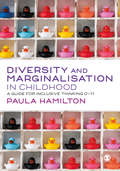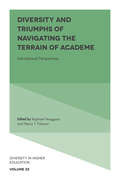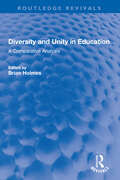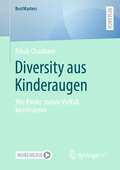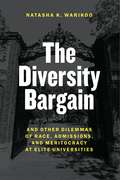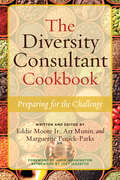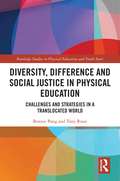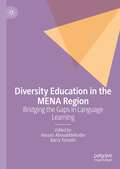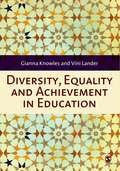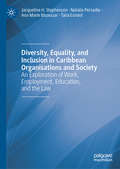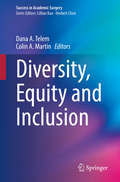- Table View
- List View
Diversity and Marginalisation in Childhood: A Guide for Inclusive Thinking 0-11
by Paula HamiltonThis core text offers you an accessible foundation to the topics of diversity, inclusion and marginalisation. Not only will you develop an understanding of how marginalisation happens, you will be encouraged to question and challenge policy and practice through case studies, reflective questions and activities. The book analyses issues encountered by marginalised groups and the impact these may have on the lives of those concerned, together with how you, as a practitioner, can help to empower these individuals and groups. With key chapters bringing attention to less cited marginalised groups such as transgender children, children with mental health conditions and looked after children, the author critically analyses the difficulties and challenges of inclusive ideology in practice, the role of mass media in reinforcing prejudice and examines theoretical frameworks and concepts related to marginalisation, inclusion and diversity.
Diversity and Marginalisation in Childhood: A Guide for Inclusive Thinking 0-11
by Paula HamiltonThis core text offers you an accessible foundation to the topics of diversity, inclusion and marginalisation. Not only will you develop an understanding of how marginalisation happens, you will be encouraged to question and challenge policy and practice through case studies, reflective questions and activities. The book analyses issues encountered by marginalised groups and the impact these may have on the lives of those concerned, together with how you, as a practitioner, can help to empower these individuals and groups. With key chapters bringing attention to less cited marginalised groups such as transgender children, children with mental health conditions and looked after children, the author critically analyses the difficulties and challenges of inclusive ideology in practice, the role of mass media in reinforcing prejudice and examines theoretical frameworks and concepts related to marginalisation, inclusion and diversity.
Diversity and Marginalisation in Childhood: A Guide for Inclusive Thinking 0-11
by Paula HamiltonThis core text offers you an accessible foundation to the topics of diversity, inclusion and marginalisation. Not only will you develop an understanding of how marginalisation happens, you will be encouraged to question and challenge policy and practice through case studies, reflective questions and activities. The book analyses issues encountered by marginalised groups and the impact these may have on the lives of those concerned, together with how you, as a practitioner, can help to empower these individuals and groups. With key chapters bringing attention to less cited marginalised groups such as transgender children, children with mental health conditions and looked after children, the author critically analyses the difficulties and challenges of inclusive ideology in practice, the role of mass media in reinforcing prejudice and examines theoretical frameworks and concepts related to marginalisation, inclusion and diversity.
Diversity and Triumphs of Navigating the Terrain of Academe: International Perspectives (Diversity in Higher Education #23)
by Raphael Heaggans Henry T. FriersonMany challenges are faced by under-represented groups in academia. Difficulties during the tenure process, prejudice stemming from affirmative action and higher levels of scrutiny than their colleagues are just a few tribulations experienced by faculty members from minority groups that have gone unnoticed and often ignored.The contributors of Diversity and Triumphs of Navigating the Terrain of Academe share these narratives and tell of how faculty navigate through situations such as microaggressions, racism and sexism. By taking an anecdotal approach, this volume captures the experiences of those who teach at institutions dominated by white males in the United States and abroad. This book is written as a treatise to dismantle the powers of discriminatory incubuses that have haunted institutions of higher learning, one narrative at a time. Some of these institutions are still making history in hiring its first person of color within its departments. Collectively, the contributors' experiences serve as instrumentalities that work together to initiate dialogue among current and future members of the professoriate, making this title an invaluable text for researchers and higher education administrators alike.
Diversity and Triumphs of Navigating the Terrain of Academe: International Perspectives (Diversity in Higher Education #23)
by Raphael Heaggans Henry T. FriersonMany challenges are faced by under-represented groups in academia. Difficulties during the tenure process, prejudice stemming from affirmative action and higher levels of scrutiny than their colleagues are just a few tribulations experienced by faculty members from minority groups that have gone unnoticed and often ignored.The contributors of Diversity and Triumphs of Navigating the Terrain of Academe share these narratives and tell of how faculty navigate through situations such as microaggressions, racism and sexism. By taking an anecdotal approach, this volume captures the experiences of those who teach at institutions dominated by white males in the United States and abroad. This book is written as a treatise to dismantle the powers of discriminatory incubuses that have haunted institutions of higher learning, one narrative at a time. Some of these institutions are still making history in hiring its first person of color within its departments. Collectively, the contributors' experiences serve as instrumentalities that work together to initiate dialogue among current and future members of the professoriate, making this title an invaluable text for researchers and higher education administrators alike.
Diversity and Unity in Education: A Comparative analysis (Routledge Revivals)
by Brian HolmesFirst published in 1980, Diversity and Unity in Education is the result of a conference set up to analyse criteria of diversity in education, comment on the politics of decision-making where diversity exists, and review in comparative perspective policies within countries and regions which have been designed to achieve educational harmony. Issues associated with the provision of separate education on the basis of sex and intelligence are identified and discussed. The extent to which national and local government officials, teachers and parents should, and do, participate in policy decisions is also analysed. International organisations, research workers and consultants will find the volume valuable for the direction it gives to research studies in education. University teachers of comparative education and those involved in multicultural education will find topics on which further research can be developed and postgraduate teaching can be based. The contributors are all distinguished international educationalists who have devoted their careers to the analysis of multicultural education in a world perspective. They are drawn from east and west Europe, North America, Africa and Latin America.
Diversity and Unity in Education: A Comparative analysis (Routledge Revivals)
by Brian HolmesFirst published in 1980, Diversity and Unity in Education is the result of a conference set up to analyse criteria of diversity in education, comment on the politics of decision-making where diversity exists, and review in comparative perspective policies within countries and regions which have been designed to achieve educational harmony. Issues associated with the provision of separate education on the basis of sex and intelligence are identified and discussed. The extent to which national and local government officials, teachers and parents should, and do, participate in policy decisions is also analysed. International organisations, research workers and consultants will find the volume valuable for the direction it gives to research studies in education. University teachers of comparative education and those involved in multicultural education will find topics on which further research can be developed and postgraduate teaching can be based. The contributors are all distinguished international educationalists who have devoted their careers to the analysis of multicultural education in a world perspective. They are drawn from east and west Europe, North America, Africa and Latin America.
Diversity aus Kinderaugen: Wie Kinder soziale Vielfalt konstruieren (BestMasters)
by Rihab Chaabane"Das ist alles Mensch!" So beschreibt ein vierjähriger Junge aus einer Münchner Kita die Vielfalt menschlicher Lebensweisen im Interview mit der Autorin. Alter, Geschlecht, Herkunft: So haben wir gelernt, gesellschaftliche Vielfalt zu kategorisieren. Doch wie machen es Kinder? In ihrer Studie setzt sich Rihab Chaabane über 38 bildbasierte Kinder-Interviews mit der Frage auseinander, wie sie soziale Vielfalt wahrnehmen und beschreiben. In den Vergleichen zwischen den Geschlechtern, Kita- und Schulkindern und zwischen zwei verschiedenen Milieus werden auf allen drei Vergleichsebenen Unterschiede festgestellt. Dies macht deutlich, dass Alter, Geschlecht und soziales Milieu sich auf die individuelle Konstruktion von Vielfalt auswirken. Diese Ergebnisse heben nochmals die Wichtigkeit einer früh beginnenden vorurteilsbewussten Pädagogik hervor. Zudem wird aus den Erkenntnissen dieser Studie heraus eine Öffnung der Vielfaltsdiskurse gegenüber neuen Dimensionen befürwortet. Auf diese Weise könnten die von den Kindern (neu) hervorgebrachten Kategorien Einzug in Diversitätskonzepte finden und so neue Betrachtungsebenen ermöglichen.
The Diversity Bargain: And Other Dilemmas of Race, Admissions, and Meritocracy at Elite Universities
by Natasha K. WarikooWe’ve heard plenty from politicians and experts on affirmative action and higher education, about how universities should intervene—if at all—to ensure a diverse but deserving student population. But what about those for whom these issues matter the most? In this book, Natasha K. Warikoo deeply explores how students themselves think about merit and race at a uniquely pivotal moment: after they have just won the most competitive game of their lives and gained admittance to one of the world’s top universities. What Warikoo uncovers—talking with both white students and students of color at Harvard, Brown, and Oxford—is absolutely illuminating; and some of it is positively shocking. As she shows, many elite white students understand the value of diversity abstractly, but they ignore the real problems that racial inequality causes and that diversity programs are meant to solve. They stand in fear of being labeled a racist, but they are quick to call foul should a diversity program appear at all to hamper their own chances for advancement. The most troubling result of this ambivalence is what she calls the “diversity bargain,” in which white students reluctantly agree with affirmative action as long as it benefits them by providing a diverse learning environment—racial diversity, in this way, is a commodity, a selling point on a brochure. And as Warikoo shows, universities play a big part in creating these situations. The way they talk about race on campus and the kinds of diversity programs they offer have a huge impact on student attitudes, shaping them either toward ambivalence or, in better cases, toward more productive and considerate understandings of racial difference. Ultimately, this book demonstrates just how slippery the notions of race, merit, and privilege can be. In doing so, it asks important questions not just about college admissions but what the elite students who have succeeded at it—who will be the world’s future leaders—will do with the social inequalities of the wider world.
The Diversity Bargain: And Other Dilemmas of Race, Admissions, and Meritocracy at Elite Universities
by Natasha K. WarikooWe’ve heard plenty from politicians and experts on affirmative action and higher education, about how universities should intervene—if at all—to ensure a diverse but deserving student population. But what about those for whom these issues matter the most? In this book, Natasha K. Warikoo deeply explores how students themselves think about merit and race at a uniquely pivotal moment: after they have just won the most competitive game of their lives and gained admittance to one of the world’s top universities. What Warikoo uncovers—talking with both white students and students of color at Harvard, Brown, and Oxford—is absolutely illuminating; and some of it is positively shocking. As she shows, many elite white students understand the value of diversity abstractly, but they ignore the real problems that racial inequality causes and that diversity programs are meant to solve. They stand in fear of being labeled a racist, but they are quick to call foul should a diversity program appear at all to hamper their own chances for advancement. The most troubling result of this ambivalence is what she calls the “diversity bargain,” in which white students reluctantly agree with affirmative action as long as it benefits them by providing a diverse learning environment—racial diversity, in this way, is a commodity, a selling point on a brochure. And as Warikoo shows, universities play a big part in creating these situations. The way they talk about race on campus and the kinds of diversity programs they offer have a huge impact on student attitudes, shaping them either toward ambivalence or, in better cases, toward more productive and considerate understandings of racial difference. Ultimately, this book demonstrates just how slippery the notions of race, merit, and privilege can be. In doing so, it asks important questions not just about college admissions but what the elite students who have succeeded at it—who will be the world’s future leaders—will do with the social inequalities of the wider world.
The Diversity Bargain: And Other Dilemmas of Race, Admissions, and Meritocracy at Elite Universities
by Natasha K. WarikooWe’ve heard plenty from politicians and experts on affirmative action and higher education, about how universities should intervene—if at all—to ensure a diverse but deserving student population. But what about those for whom these issues matter the most? In this book, Natasha K. Warikoo deeply explores how students themselves think about merit and race at a uniquely pivotal moment: after they have just won the most competitive game of their lives and gained admittance to one of the world’s top universities. What Warikoo uncovers—talking with both white students and students of color at Harvard, Brown, and Oxford—is absolutely illuminating; and some of it is positively shocking. As she shows, many elite white students understand the value of diversity abstractly, but they ignore the real problems that racial inequality causes and that diversity programs are meant to solve. They stand in fear of being labeled a racist, but they are quick to call foul should a diversity program appear at all to hamper their own chances for advancement. The most troubling result of this ambivalence is what she calls the “diversity bargain,” in which white students reluctantly agree with affirmative action as long as it benefits them by providing a diverse learning environment—racial diversity, in this way, is a commodity, a selling point on a brochure. And as Warikoo shows, universities play a big part in creating these situations. The way they talk about race on campus and the kinds of diversity programs they offer have a huge impact on student attitudes, shaping them either toward ambivalence or, in better cases, toward more productive and considerate understandings of racial difference. Ultimately, this book demonstrates just how slippery the notions of race, merit, and privilege can be. In doing so, it asks important questions not just about college admissions but what the elite students who have succeeded at it—who will be the world’s future leaders—will do with the social inequalities of the wider world.
The Diversity Bargain: And Other Dilemmas of Race, Admissions, and Meritocracy at Elite Universities
by Natasha K. WarikooWe’ve heard plenty from politicians and experts on affirmative action and higher education, about how universities should intervene—if at all—to ensure a diverse but deserving student population. But what about those for whom these issues matter the most? In this book, Natasha K. Warikoo deeply explores how students themselves think about merit and race at a uniquely pivotal moment: after they have just won the most competitive game of their lives and gained admittance to one of the world’s top universities. What Warikoo uncovers—talking with both white students and students of color at Harvard, Brown, and Oxford—is absolutely illuminating; and some of it is positively shocking. As she shows, many elite white students understand the value of diversity abstractly, but they ignore the real problems that racial inequality causes and that diversity programs are meant to solve. They stand in fear of being labeled a racist, but they are quick to call foul should a diversity program appear at all to hamper their own chances for advancement. The most troubling result of this ambivalence is what she calls the “diversity bargain,” in which white students reluctantly agree with affirmative action as long as it benefits them by providing a diverse learning environment—racial diversity, in this way, is a commodity, a selling point on a brochure. And as Warikoo shows, universities play a big part in creating these situations. The way they talk about race on campus and the kinds of diversity programs they offer have a huge impact on student attitudes, shaping them either toward ambivalence or, in better cases, toward more productive and considerate understandings of racial difference. Ultimately, this book demonstrates just how slippery the notions of race, merit, and privilege can be. In doing so, it asks important questions not just about college admissions but what the elite students who have succeeded at it—who will be the world’s future leaders—will do with the social inequalities of the wider world.
The Diversity Bargain: And Other Dilemmas of Race, Admissions, and Meritocracy at Elite Universities
by Natasha K. WarikooWe’ve heard plenty from politicians and experts on affirmative action and higher education, about how universities should intervene—if at all—to ensure a diverse but deserving student population. But what about those for whom these issues matter the most? In this book, Natasha K. Warikoo deeply explores how students themselves think about merit and race at a uniquely pivotal moment: after they have just won the most competitive game of their lives and gained admittance to one of the world’s top universities. What Warikoo uncovers—talking with both white students and students of color at Harvard, Brown, and Oxford—is absolutely illuminating; and some of it is positively shocking. As she shows, many elite white students understand the value of diversity abstractly, but they ignore the real problems that racial inequality causes and that diversity programs are meant to solve. They stand in fear of being labeled a racist, but they are quick to call foul should a diversity program appear at all to hamper their own chances for advancement. The most troubling result of this ambivalence is what she calls the “diversity bargain,” in which white students reluctantly agree with affirmative action as long as it benefits them by providing a diverse learning environment—racial diversity, in this way, is a commodity, a selling point on a brochure. And as Warikoo shows, universities play a big part in creating these situations. The way they talk about race on campus and the kinds of diversity programs they offer have a huge impact on student attitudes, shaping them either toward ambivalence or, in better cases, toward more productive and considerate understandings of racial difference. Ultimately, this book demonstrates just how slippery the notions of race, merit, and privilege can be. In doing so, it asks important questions not just about college admissions but what the elite students who have succeeded at it—who will be the world’s future leaders—will do with the social inequalities of the wider world.
The Diversity Bargain: And Other Dilemmas of Race, Admissions, and Meritocracy at Elite Universities
by Natasha K. WarikooWe’ve heard plenty from politicians and experts on affirmative action and higher education, about how universities should intervene—if at all—to ensure a diverse but deserving student population. But what about those for whom these issues matter the most? In this book, Natasha K. Warikoo deeply explores how students themselves think about merit and race at a uniquely pivotal moment: after they have just won the most competitive game of their lives and gained admittance to one of the world’s top universities. What Warikoo uncovers—talking with both white students and students of color at Harvard, Brown, and Oxford—is absolutely illuminating; and some of it is positively shocking. As she shows, many elite white students understand the value of diversity abstractly, but they ignore the real problems that racial inequality causes and that diversity programs are meant to solve. They stand in fear of being labeled a racist, but they are quick to call foul should a diversity program appear at all to hamper their own chances for advancement. The most troubling result of this ambivalence is what she calls the “diversity bargain,” in which white students reluctantly agree with affirmative action as long as it benefits them by providing a diverse learning environment—racial diversity, in this way, is a commodity, a selling point on a brochure. And as Warikoo shows, universities play a big part in creating these situations. The way they talk about race on campus and the kinds of diversity programs they offer have a huge impact on student attitudes, shaping them either toward ambivalence or, in better cases, toward more productive and considerate understandings of racial difference. Ultimately, this book demonstrates just how slippery the notions of race, merit, and privilege can be. In doing so, it asks important questions not just about college admissions but what the elite students who have succeeded at it—who will be the world’s future leaders—will do with the social inequalities of the wider world.
The Diversity Consultant Cookbook: Preparing for the Challenge
by Eddie Moore Art Munin Marguerite W. Penick-ParksWritten to advise how to get started in, and develop a career as, diversity consultants. This succinct cookbook provides the guidance to get you going and succeed.The cookbook metaphor reflects the delicate nature of diversity consulting where the little things can make a significant difference in the final outcome. As with cooking where a dash of seasoning, the choice of temperature, or cooking time, impact the final dish, so the wrong balance in creating an environment that is welcoming and constructive while addressing issues that may be disorienting for the audience can ruin a presentation before it gets started. Like a cookbook, this book is set out in small chunks. It covers the need to audit and enhance your skills and knowledge, establish your brand and what you distinctively bring to the table, develop your outreach and contacts, and learn to listen to clients to determine what interventions will achieve their long-term goals.It addresses developing your strategic plan with a clear sense of mission, vision, and values; moves on to topics such as financial planning, pricing, contracts, scheduling, and considerations about presentation styles and handouts; and gets down to the specifics of marketing, with ideas on business cards, websites, networking, and even how to dress. For anyone contemplating embarking on a career as a diversity consultant – either part-time while holding an existing position or as a full-time endeavor, this is an invaluable guide for getting started, and for keeping at your side as you develop your practice.
The Diversity Consultant Cookbook: Preparing for the Challenge
by Eddie Moore Art Munin Marguerite W. Penick-ParksWritten to advise how to get started in, and develop a career as, diversity consultants. This succinct cookbook provides the guidance to get you going and succeed.The cookbook metaphor reflects the delicate nature of diversity consulting where the little things can make a significant difference in the final outcome. As with cooking where a dash of seasoning, the choice of temperature, or cooking time, impact the final dish, so the wrong balance in creating an environment that is welcoming and constructive while addressing issues that may be disorienting for the audience can ruin a presentation before it gets started. Like a cookbook, this book is set out in small chunks. It covers the need to audit and enhance your skills and knowledge, establish your brand and what you distinctively bring to the table, develop your outreach and contacts, and learn to listen to clients to determine what interventions will achieve their long-term goals.It addresses developing your strategic plan with a clear sense of mission, vision, and values; moves on to topics such as financial planning, pricing, contracts, scheduling, and considerations about presentation styles and handouts; and gets down to the specifics of marketing, with ideas on business cards, websites, networking, and even how to dress. For anyone contemplating embarking on a career as a diversity consultant – either part-time while holding an existing position or as a full-time endeavor, this is an invaluable guide for getting started, and for keeping at your side as you develop your practice.
Diversity, Difference and Social Justice in Physical Education: Challenges and Strategies in a Translocated World (Routledge Studies in Physical Education and Youth Sport)
by Bonnie Pang Tony RossiThis book presents a detailed analysis of the experiences of (minority ethnic) physical education (PE) teachers in both schools and higher education contexts. It examines and questions the lack of ethnic diversity in PE teacher education in high-income developed countries and suggests important new directions for transformative pedagogy to address the ‘whiteness’ of PE. The book draws on auto-ethnographical research conducted in Sydney, Australia—one of the world’s most culturally diverse cities—and in cities of the United Kingdom. The study is rooted in the concept of ‘trans-locality’, the networks that extend beyond the immediate community. It explores the challenges faced by PE teachers in culturally diverse workplaces, and the interconnections between place, institutions, and the parallel processes of mobility and globalisation. To understand and theorise the myriad of interactions and practice around diversity, differences, and social justice among lecturers, teachers, and students across the two locations, the book offers an emerging area of scholarship that focuses on a trans-local perspective in diversity and inclusion in Physical Education Teacher Education (PETE). Diversity, Difference and Social Justice in Physical Education will be of significance to those who manage, teach, and research issues associated with diversity and advocate for diversifying the teaching workforce in PETE.
Diversity, Difference and Social Justice in Physical Education: Challenges and Strategies in a Translocated World (Routledge Studies in Physical Education and Youth Sport)
by Bonnie Pang Tony RossiThis book presents a detailed analysis of the experiences of (minority ethnic) physical education (PE) teachers in both schools and higher education contexts. It examines and questions the lack of ethnic diversity in PE teacher education in high-income developed countries and suggests important new directions for transformative pedagogy to address the ‘whiteness’ of PE. The book draws on auto-ethnographical research conducted in Sydney, Australia—one of the world’s most culturally diverse cities—and in cities of the United Kingdom. The study is rooted in the concept of ‘trans-locality’, the networks that extend beyond the immediate community. It explores the challenges faced by PE teachers in culturally diverse workplaces, and the interconnections between place, institutions, and the parallel processes of mobility and globalisation. To understand and theorise the myriad of interactions and practice around diversity, differences, and social justice among lecturers, teachers, and students across the two locations, the book offers an emerging area of scholarship that focuses on a trans-local perspective in diversity and inclusion in Physical Education Teacher Education (PETE). Diversity, Difference and Social Justice in Physical Education will be of significance to those who manage, teach, and research issues associated with diversity and advocate for diversifying the teaching workforce in PETE.
Diversity Education in the MENA Region: Bridging the Gaps in Language Learning
by Hassan Abouabdelkader Barry TomalinThis book outlines a landscape of diversity education in the MENA region and its repercussions on learners' abilities, outcomes, and prospects. It addresses the concerns of language educators, curriculum designers, language education researchers, students and trainers. Theoretically, the issues of diversity, inclusion and equity share common principles and insights; yet they are not conceived of in this book as interchangeable. These subtle distinctions, as delineated in this book, show that they are complementary and include the principles of quality education which leverage human rights, sustainability and promotion of the human capital. What makes this book distinctive is that it reconsiders the existing pedagogical trends in terms of the current social upheavals, and with reference to the principles of development and progress needed in twenty-first century education.
Diversity, Equality and Achievement in Education
by Gianna Knowles Vini LanderMost classrooms contain children from a variety of backgrounds, where home culture, religious beliefs and the family′s economic situation all impact on achievement. This needs to be recognised by teachers in order to establish fair, respectful, trusting and constructive relationships with children and their families, which will allow every child to reach their full potential. This book looks at real issues that affect teachers in the classroom, and examines a variety of influences affecting child development. It provides you with the theoretical and practical information you need to ensure you understand the complex factors which affect the children in your care, and it encourages good, thoughtful teaching. Dealing with some of the less widely addressed aspects of diversity and inclusion, the book considers: - children who are asylum seekers - the notion of ′pupil voice′ - what diversity and equality mean in practice - gender and achievement - looked-after children - social class - disability - ethnicity and whiteness This book is essential reading for any education student looking at diversity and inclusion, and for teachers in role looking for advice on how to meet the professional standards.
Diversity, Equality and Achievement in Education
by Gianna Knowles Vini LanderMost classrooms contain children from a variety of backgrounds, where home culture, religious beliefs and the family′s economic situation all impact on achievement. This needs to be recognised by teachers in order to establish fair, respectful, trusting and constructive relationships with children and their families, which will allow every child to reach their full potential. This book looks at real issues that affect teachers in the classroom, and examines a variety of influences affecting child development. It provides you with the theoretical and practical information you need to ensure you understand the complex factors which affect the children in your care, and it encourages good, thoughtful teaching. Dealing with some of the less widely addressed aspects of diversity and inclusion, the book considers: - children who are asylum seekers - the notion of ′pupil voice′ - what diversity and equality mean in practice - gender and achievement - looked-after children - social class - disability - ethnicity and whiteness This book is essential reading for any education student looking at diversity and inclusion, and for teachers in role looking for advice on how to meet the professional standards.
Diversity, Equality and Achievement in Education (2nd edition) (PDF)
by Gianna KnowlesMost classrooms contain children from a variety of backgrounds, where home culture, religious beliefs and the family's economic situation all impact on achievement. This needs to be recognised by teachers in order to establish fair, respectful, trusting and constructive relationships with children and their families, which will allow every child to reach their full potential. This book looks at real issues that affect teachers in the classroom, and examines a variety of influences affecting child development. It provides you with the theoretical and practical information you need to ensure you understand the complex factors which affect the children in your care, and it encourages good, thoughtful teaching. Dealing with some of the less widely addressed aspects of diversity and inclusion, the book considers: - children who are asylum seekers - the notion of 'pupil voice' - what diversity and equality mean in practice - gender and achievement - looked-after children - social class - disability - ethnicity and whiteness This book is essential reading for any education student looking at diversity and inclusion, and for teachers in role looking for advice on how to meet the professional standards. 9781849206013
Diversity, Equality, and Inclusion in Caribbean Organisations and Society: An Exploration of Work, Employment, Education, and the Law
by Jacqueline H. Stephenson Natalie Persadie Ann Marie Bissessar Talia EsnardThis book focuses on equality, inclusion, and discrimination within the English-speaking Caribbean region, specifically as it relates to employment, education, society, and the law. Though anti-discrimination laws have recently been enacted in the Caribbean, this, in and of itself, neither translates to societal changes nor changes within the organisational context. The authors examine racial diversity in public sector organisations in Trinidad and Tobago and Guyana, gender diversity in organisations across the Caribbean region, sexual orientation and its impact on employment, disability and access within organisations, and equality and inclusion within Caribbean institutions of higher education. Further, the book explores the region’s equality laws and compares them with legislation from selected developed countries. This interdisciplinary text provides researchers in HRM, organisational behavior, sociology, and public policy with an overview of the types of discrimination prevalent within the Caribbean as well as the varied institutional frameworks in place that encourage equality.
DIVERSITY, EQUITY AND INCLUSION: CREATING VALUE-BASED SUSTAINABLE ORGANIZATIONS
by Sunita Singh Sengupta Suresh Kalagnanam P. Jyothi B. CharumathiThe benefits of high integrity and high-responsibility organizations are well[1]established conscience mechanisms based on the principles of inclusion that emphasize justice, care, and fair practices at workplaces. Superrich Amazon investor Nick Hanauer writes in Oxfam’s state of wealth inequality report published on Monday (January 21, 2019) “I am a practitioner of capitalism,” … The most important lesson I have learned from these decades of experience with market capitalism is that morality and justice are the fundamental prerequisites for prosperity and economic growth (Singh Sengupta, 2021). When leaders and organizations operate from a deep awareness of their consciousness—they naturally behave responsibly beyond what appears to be their own self-interest…The managers who integrate spiritual values with their managerial styles in the entire operations management system bring integrity and oneness to the organizations…
Diversity, Equity and Inclusion (Success in Academic Surgery)
by Dana A. Telem Colin A. MartinThis book comprehensively covers diversity, equity and inclusion (DEI) in the context of daily surgical practice. Through real-life illustrative case scenarios and experiences, this book explores DEI and its impact on academic surgery, career development, and clinical practice. Each chapter highlights a commonly encountered scenario and features extensive guidance on how to address each challenge secondary to both implicit explicit biases as well as detailing how to implement best practices. Diversity, Equity and Inclusion provides a detailed guide to the best practices and challenges associated with implementing DEI in day to day surgical practice and is a valuable resource for all surgical practitioners looking for a guide on how to successfully implement DEI strategies into daily clinical practice.
